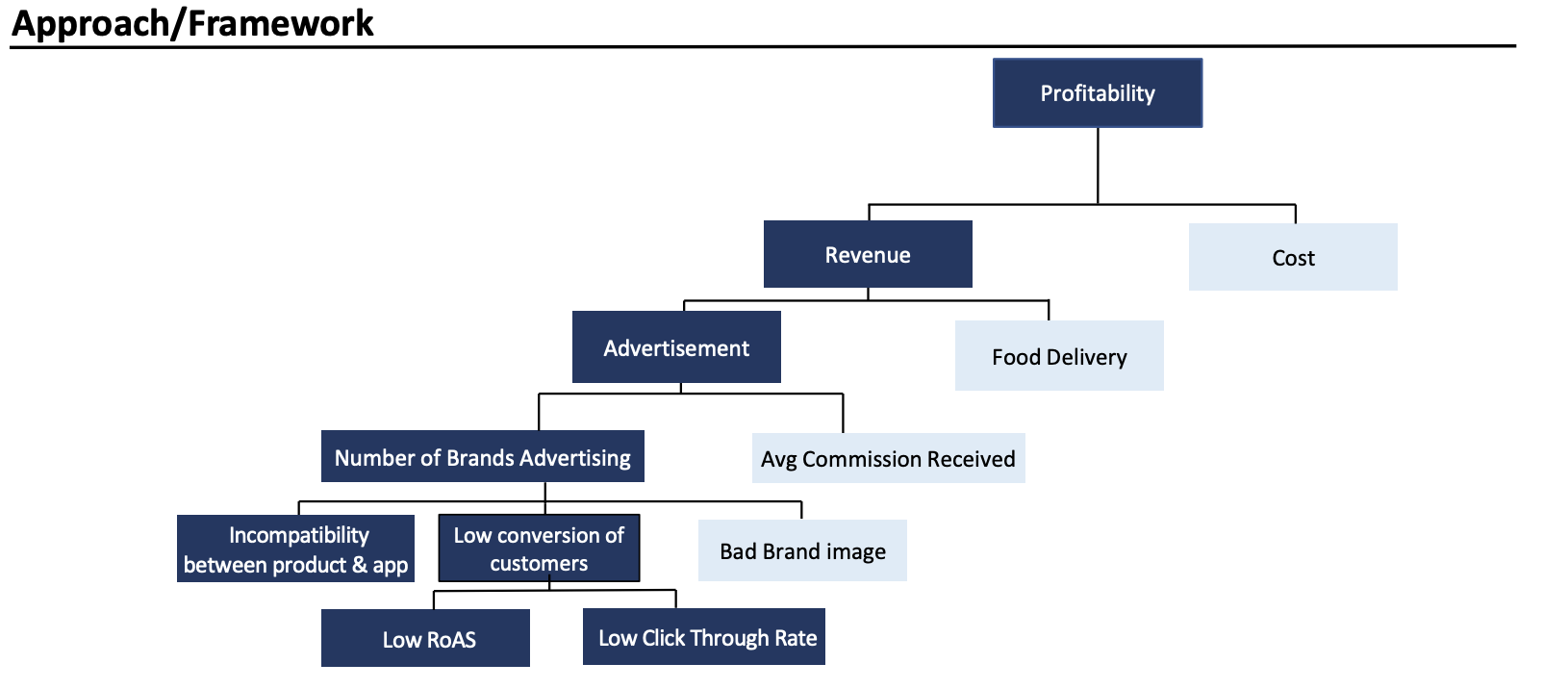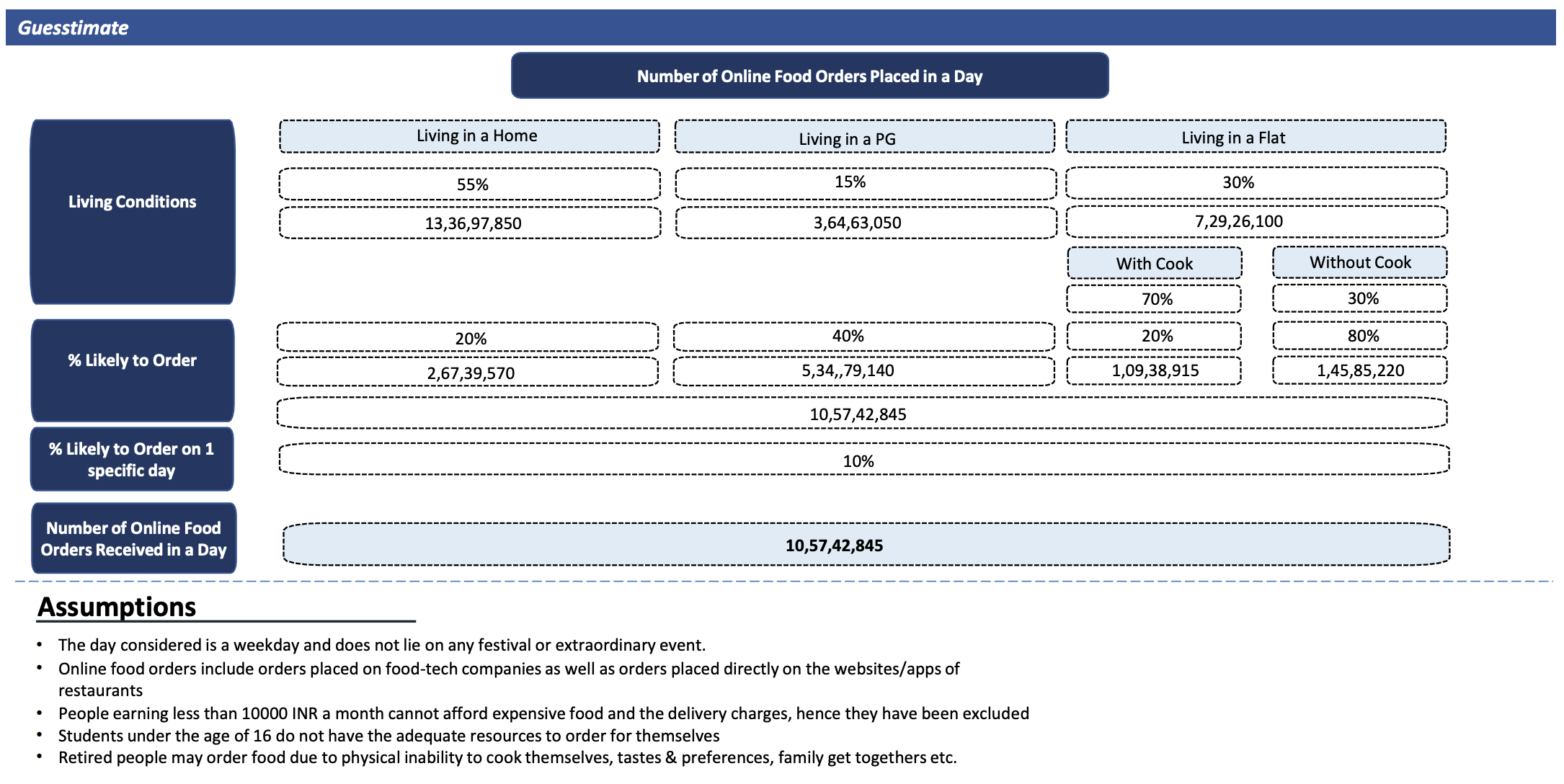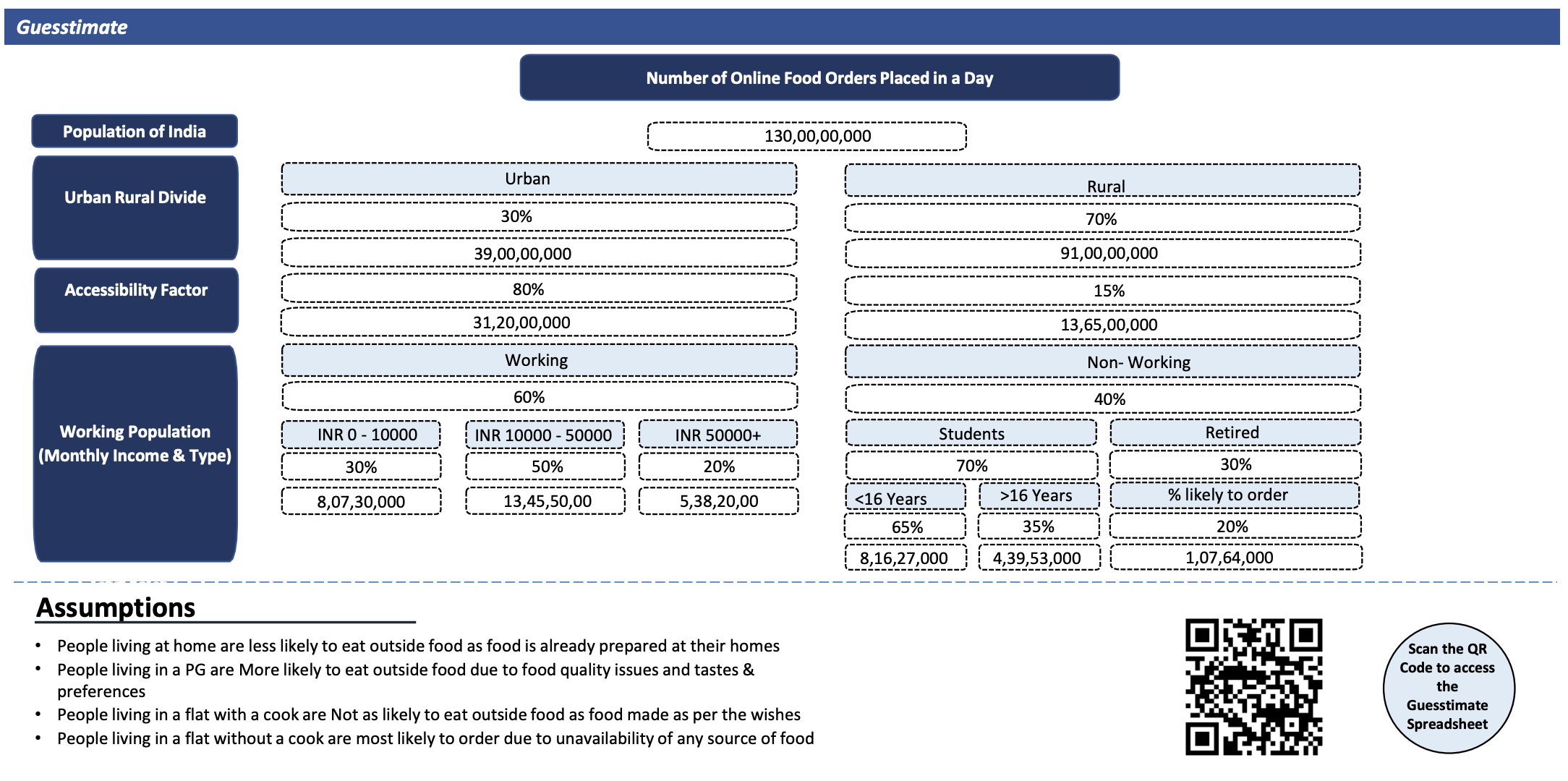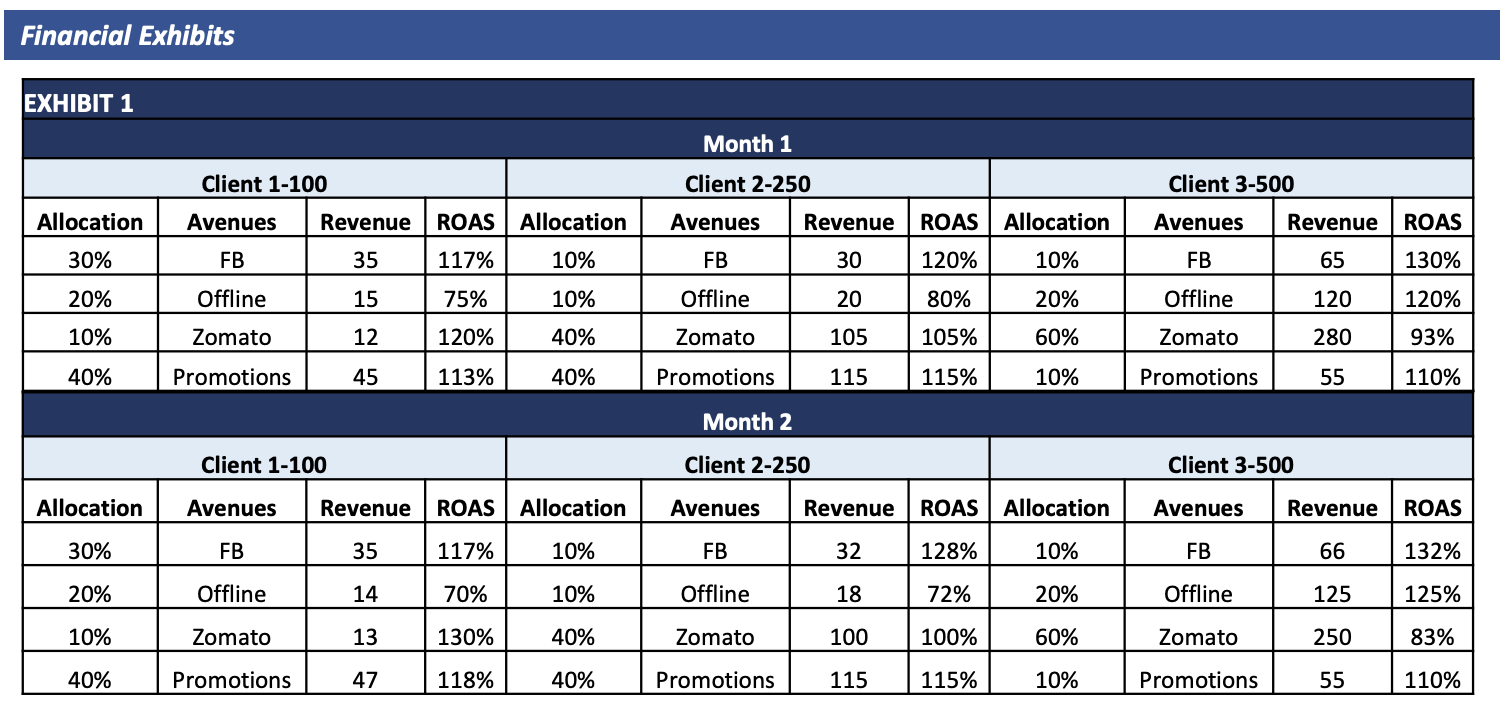What the foodie
Case Statement :
Your client is Tomato, an Indian multinational restaurant aggregator and food delivery company. It
provides information, menus and user-reviews of restaurants as well as food delivery options from
partner restaurants in select cities. It’s currently facing a decline in its profitability. You have been hired to solve this conundrum.
Interview Transcript
Your client is Tomato, an Indian multinational restaurant aggregator and food delivery company. It provides information, menus and user-reviews of restaurants as well as food delivery options from partner restaurants in select cities. It’s currently facing a decline in its profitability. You have been hired to solve this conundrum.
Is there a decline in profitability throughout the industry or is it specific to our client. For how long have they been facing such a decline?
The decline is specific to Tomato. The client has been facing the problem since the past 6 months.
Has there been any major technological upgrades?
No, there haven’t been any changes.
Have any new competitors entered the market in the past 6 months?
No, there has been no change in substantial competitors.
To analyze the problem further, I would now like to look at the revenues and costs of the business. We know that, Profit = Revenue – Costs. I’d like to start by assessing the cost side first. Cost= Fixed Costs + Variable Costs
Fixed Costs:
- Insurance: General Liability Coverage, Commercial Auto Insurance, Worker’s Compensation
- Employee Benefit Expenses
- Finance Costs
- Technology (development, deployment and maintenance)
Variable Costs:
- Delivery & Related Charges
- Advertisement & Sales Promotion
- IT Support Services
- Outsourced Support Cost
- Payment Gateway Charges
- Legal Payments
Have any of these costs been affected?
No, the costs have not been affected.
Alright. I shall look into the revenue side then. What are the revenue streams of our client and which are the major ones?
Our client generates revenue through the following streams:
- Commission on food delivery
- Restaurant listing and Advertising
- Tomato Gold Membership
- Consultancy to restaurants
Great. Do we know which of these streams has/have been affected? Or do you want me to assess any particular stream?
I would like you to assess the revenues generated by way of commission first.
So revenues here would be no. of orders x (average order value x average commission received). Have the no. of orders been affected or our commission rates changed?
Currently our commission rates have remained the same and are competitive. I would like you to estimate the number of orders received by online food apps in a day.
So, I would now come to those numbers through a guesstimate. To analyze the number of food orders received in a day in India, I took the urban and rural population of India and gave them different accessibility ratings given the current coverage of online food delivery services in India. The resulting population can be divided into the working & non working population. Amongst the working population, only people earning over 10000 a month are considered to be consumers factoring in affordability. The non working population can be divided into students & retired folks. Only students over the age of 16 are considered as only they have the resources to place an order(in case a smaller child orders, it will come under the parents working population number). A small percentage is taken in terms of retired people due to cultural practices and trends. After this, the living conditions are considered, dividing them into living in a home, a PG or a flat (with/without cook) which influences the likelihood to order food. These filters give us the number of online food orders received in a day as approximately 10.5 lakhs.
Thank you for running us through your approach. The number is quite close to our projections
Now, I would like to focus on other factors. I will consider the restaurant listing and advertising. Are there any overall changes in the advertising revenues of the company?
Yes, we are currently facing a decline in the revenue from this source.
Revenues here will be a product of the number of brands opting for advertising and the average charges for advertising. Has the no. of brands opting for advertising gone down or have there been any changes in the prices we charge for this?
The no. of brands opting for advertising has gone down
I think the following reasons can be the cause of this problem:
1.Low conversion of customers
2.Incompatibility between the product and the app.
3.Unethical practices or bad public image that causes degradation of brand value.
We have received feedback that we are unable to tap beneficial brands to advertise on our app, major reasons being non- compatibility, lower click through rates & conversions. We have the data of 2 months for 3 clients. The monthly allocation data for client 1 is 30% on Facebook, 20% offline, 10% on Tomato, 40% on promotions, giving a return of 35, 15, 12, 45 in month 1 and 35, 14, 13, 27 in month 2 on each of these allocations respectively. For client 2 it is 10% on Facebook, 10% offline, 40% on Tomato, 40% on promotion with the revenue being 30, 20, 105, 115 for month 1 and 32, 18, 100, 115 for month 2 respectively. And for client 3 it is 10% on Facebook, 20% offline, 60% on Tomato, 10% on promotions, giving 65, 120, 280, 55 for month 1 and 66, 125, 250, 55 for month 2 as the revenue. What can you infer from this data?
I can calculate the return on ad spend for each of these clients for the two months, which comes out to be 117%, 75%, 120%, 113% and 117%, 70%, 130%, 118% for month 1 and 2 respectively for client 1. Similarly, it is 120%, 80%, 105%, 115% and 128%, 72%, 100%, 115% for client 2. 130%, 120%, 93%, 110% and 132%, 125%, 83%, 110% for client 3. MoM ROAS in Tomato grows for Client 1 which has less revenue, and decreases for Client 2 & Client 3. The subsequent effect leads to bigger clients pulling out money from Tomato adverts leading to a net negative effect. Highest ROAS channel for each client moderately grows MoM whereas the lowest ROAS channel for each client moderately decreases MoM.
That is a good analysis. What could be the reasons for this low return according to you?
Reasons for low return can be:
1.Shift of target customers to the apps of competitors
2.The budget might be too low.
3.The cost per click has been enhanced.
4.Incompatibility of the brand and the app.
5.Change in food ordering preferences of customers 6.Unfriendly UI of the app/ bugs and technical difficulties
Incompatibility & Unfriendly UI are the major reasons for this low return.
I’d like to give the following suggestions to improve the compatibility and brand conversion of the app:
1.Enabling push notifications based upon the area of the user.
2.Brands can be given a dynamic option for advertising, providing different formats including main ads and other small ads.
3.Making engaging adverts that persuade the users. Video graphic ads can be used.
Great, you’ve analyzed the problem quite well and have given some really good suggestions. Thank you!
Case Facts
- Overview – Tomato, a food delivery platform facing a decline in revenue.
- Industry Scenario – Problem specific to the food delivery platform.
- Modes of Operation – Food Delivery & Restaurant listing
- Change in Regulation – None
Approach

Case Recommendation
- Enabling push notifications to improve RoAS.
- Making engaging adverts that persuade the users.
- Giving dynamic options for brands to advertise.
Brownie Points
- Identification of ROAS as a measure of effectiveness.
- Dynamic advertising option.
Guesstimates


Financial Exhibits


